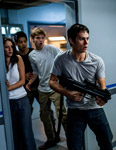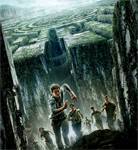Dylan O'Brien Maze Runner: The Death Cure
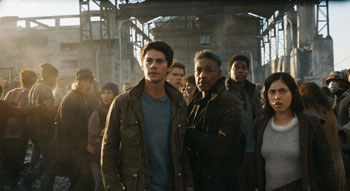
It started with the maze…
Cast: Dylan O'Brien, Thomas Brodie-Sangster, Kaya Scodelario, Nathalie Emmanuel, Katherine McNamara
Director: Wes Ball
Genre: Action, Thriller
Rated: M
Running Time: 142 minutes
Synopsis: In The Maze Runner Thomas (Dylan O'Brien) woke up as he was being delivered to the glade. He had no memory of who he was or why he'd become a member of a community of young people; among them Minho (Ki Hong Lee), lead maze runner; Newt (Thomas BrodieSangster), a good friend and advisor, Gally (Will Poulter), a leader and adversary and Teresa (Kaya Scodelario), the only female glader, with whom Thomas may have a potentially dark history. Together they are trapped, surrounded by 200 foot walls and an ever-changing maze.
Bad turns to worse when the gladers finally escape the maze only to discover they are in the middle of a desolate wasteland called The Scorch. In Maze Runner: The Scorch Trials, Thomas and the surviving gladers met new allies while discovering clues about a mysterious group behind all of their 'tests" – an organization known as WCKD.
With Maze Runner: The Death Cure the motives of WCKD become clearer: Dr. Ava Paige, WCKD's executive director is close to what she believes is a cure for the disease known as The Flare, an infection that has decimated the world's population. But the cure comes by sacrificing the few young people left in the world who are apparently immune. In order to free those who have been rounded up as test subjects, including his friend Minho, Thomas must now band together with fellow survivors, old and new, and take the battle to what may be the last remaining city and the final stronghold of WCKD. He must break into the super-secure WKCD headquarters and try to bring down the organization from the inside.
Action reaches new heights in this mission-oriented third and final segment of The Maze Runner Series. The Wes Ball-directed adaptation of the bestselling James Dashner YA trilogy is a 20th Century Fox production. The screenplay was written by T.S. Nowlin. Producers are Ellen Goldsmith-Vein of The Gotham Group, Wyck Godfrey and Marty Bowen of Temple Hill Productions Joe Hartwick, Jr., Wes Ball, and Lee Stollman. The film is scheduled for a January 18th, 2018 release.
Maze Runner: The Death Cure
Release Date: January 18th, 2018
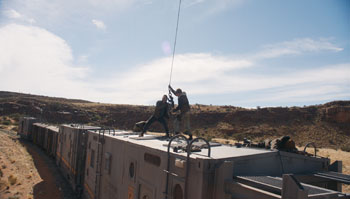 About The Production
About The Production
'Long way from the glade, aren't we?"
The Maze Runner, which was the first of a trilogy of stories based on the James Dashner novels, started shooting on May 15, 2013 in Baton Rouge, Louisiana. It brought together a diverse and talented group of young actors.
In the original Maze Runner the involuntary inhabitants of the mysterious encampment knows as The Glade were surrounded by an ever-changing maze with 200 foot walls. They were a colony of young men with a singular goal; escape the glade by solving the maze. When Thomas showed up and, shortly after, the glade's first girl inhabitant Teresa, everything began to change. The way out led them to the truth: they were members in an immense and cruel test.
In Maze Runner: The Scorch Trials the 'gladers", as they were now known, discovered that once out of the maze they were not the only participants forced to endure tests. There were in fact other mazes, other survivors and they were to learn of the organisation that had selected them, WCKD. Thomas, who had become the presumptive leader of the group, didn't trust the message he was hearing that 'WCKD is good." Breaking free from the compound where they'd been housed after being 'rescued" Thomas led the survivors of the original maze and others he had encountered in the new facility out into 'the scorch", a desert wasteland that appeared to be all that was left of the world.
Looking for a rumored safe haven, the group became trapped when Teresa, conflicted about WCKD and its true mission, gave up the hidden location of the surviving assemblage and a WCKD resistance group known as The Right Arm. Having been betrayed by Teresa, and vowing to save Minho, who has been abducted by WCKD, Thomas concluded The Scorch Trials with a single declaration, 'I'm going to put a stop to them. I'm going to kill Ava Paige." The woman who had become synonymous with the organization enigmatically named WCKD had now become his nemesis.
Maze Runner: The Death Cure, picks up roughly six months after the Scorch Trials ended. In the final battle of The Scorch the survivors of The Flare, a disease that has devastated the world's population, have defined their purpose; to find a safe haven away from the influence of WCKD. This exciting conclusion of the Maze Runner trilogy reunites many of the original cast members from 2014's The Maze Runner; Dylan O'Brien as Thomas; Kaya Scodelario as Teresa; Ki Hong Lee as Minho; Thomas Brodie-Sangster as Newt; Dexter Darden as Frypan and Patricia Clarkson as Dr. Ava Paige along with newer cast members from Maze Runner: The Scorch Trials; Giancarlo Esposito as Jorge, Rosa Salazar as Brenda, Aidan Gillen as Janson, Barry Pepper as Vince and Walton Goggins as Lawrence. The cast, along with many others from the original Maze Runner filmmaking team came together for a three-month long shoot in Cape Town, South Africa where cameras started rolling on March 6, 2017.
As the director of all three films Wes Ball describes the differences in the worlds where each story takes place: 'The first film, with the maze, was all cement and decay. The second story was the sand and rust of the scorch and this film, The Death Cure, is a world of glass and steel. They each have their own tone and color palate." But it's the world of steel and glass, a world that the gladers are not even certain exists that will become the target as they take the battle to WCKD.
The battle against WKCD actually started at the end of Scorch Trials. As Wes Ball explains: 'In the third book there's this whole idea of a resistance, a group opposed to WCKD and I thought -Wouldn't it be nice to bring that in early?'" Having the warring factions show up at the end of the second movie is a slight deviation from the book and Ball is grateful to have the latitude to make those kinds of creative adjustments. 'There are things that aren't exactly like the book but they're inspired by the books and that's why we're fortunate that James (Dashner) was on board for all of this stuff and the choices we're making. We wanted to do what we could with respect to the fans and what they want to see."
James Dashner confirmed his approval, stating, 'The fans of the books are very loyal to the stories and very protective of them but some things just work better in a cinematic universe. Wes Ball has been great in finding those things that I think the fans have embraced as well."
To create this journey the production needed a location that would provide all of the diversity of the scorch, to the city, to the safe haven and everything in between. To achieve this they traveled to Cape Town, South Africa. Named the World Design Capital in 2014 by the International Council of Societies of Industrial Design, the southern cape provided the perfect backdrop for the 'last city" with its tall buildings and modern architecture.
The location also afforded the production the chance to travel to the edge of the Kalahari Desert to shoot the film's exciting opening train sequence. The scene, shot over five days near the town of Upington makes for an exciting, hit-the-ground-running, opening sequence. 'I think it's going to be one of the coolest sequences we've ever done," says Dylan O'Brien. 'It's a great way to kick off the film and absolutely sets the tone. The whole movie's really a rescue mission and it's a special sequence in this exciting trilogy."
Dylan O'Brien appreciated the scene because it allowed audiences to pick up seamlessly from the last film. 'Scorch Trials started at the exact moment that the first film ended. With this film, it been about six months and you can see that these guys have been busy. They've taken that time to get organised, to come up with a plane and to go save Minho."
Wes Ball describes that instant at the end of Scorch Trials, when the others turn to Thomas and asks if he has a plan, as a defining moment for the character: 'You see the leader emerge," he says simply.
When Death Cure opens, it is clear the team have had time to come up with their plan. They are a different group, organized and on the offensive. It's a plan so audacious it requires that they steal an entire moving train car in their attempt to save Minho.
'The train heist was good fun," says Berry Pepper, who plays Vince, a leader of the Right Arm resistance. 'Definitely one of the highlights of filming. It's amazing, it was so hot out in the Kalahari. I'd be doing an action sequence, leaping from the car, climbing the train, and I'd be soaked to the bone, and then I'd stand around for ten minutes and I'd be dry. The sun was just so baking hot. I'd never experienced that before, that kind of heat. But it was also equally stunning, just beautiful out there. I'd never been in a location like that before, it was a great leg of the shoot, for sure."
Rosa Salazar, who plays Brenda described the location as a very good match for the New Mexico location where Scorch Trials ended. 'When you travel to Upington, you think this could be Albuquerque. The terrain is extremely similar. This could be wherevers'ville, Montana… then a group of villagers come, and you realize very quickly, you're in Africa! There's a completely different thing that happens in your brain when you realize you're in Africa. You aren't in Albuquerque or wherevers'ville America. You're in a place where people still band together and they rise up. Where people have an interest in what's going on around them and they say it and they vocalize it and they fight. People here, they will fight, they will rise up. And I love that because that's what this movie is about."
Having rescued a train car full of young people, all immune to The Flare, headed for the test labs of WCKD, the ultimate goal is get everyone to the safe haven. Once again, it is a place that no one was sure really existed. First introduced in The Scorch Trials when Brenda tells Thomas, 'Jorge thinks you guys are a ticket to the safe haven," it's a moment screenwriter T. S. Nowlin describes as 'the carrot at the end of the stick. The moment they hear there is a paradise."
The one to shepherd the growing number of young people to this new place to live is Vince. 'He's just a survivor," says Pepper about his character. 'I think like everyone he's been forced to buck up or die. WCKD has the antidote and they pretty much hold everyone's lives in the palm of their hands. So, he's trying to survive and take as many people with him as he can." For the spectacular beauty of the 'safe haven" the filmmakers and cast members went to the South African coastal park Koel Bay and the Kogel Bay Beach Resort. With sheer mountains jutting up around the scenic beaches, it provided production designer Daniel Dorrance with the perfect spot to create the camp which in many ways mimics the look of the original gladers camp. The difference being, instead of the steep walls of the maze being a prison, the mountains provide security.
Bringing an already spectacular location into the Maze Runner universe was a perfect fit for Dorrance's talent. As Wes Ball explains, 'Dan is really good at taking a practical location and turning into something very cool, unique and special."
'Once we found this beautiful beach," notes Dorrance, 'we knew we could erect tent-like structures on them and have kind of the beginning of their world, which has sort of gone full circle back to the maze, in that they lived off the land."
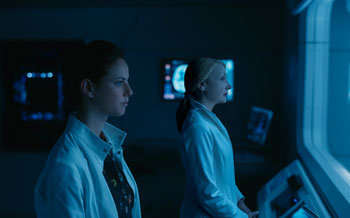 'I said I had a way in… I didn't say you were going to like it."
'I said I had a way in… I didn't say you were going to like it."-Gally
In creating the impenetrable WCKD headquarters and laboratory, production used the sleek design of the Cape Town International Convention Center as the exterior. The interior and the WCKD Lab on the 20th floor was a massive set constructed in a converted warehouse just outside of Cape Town. Construction on the sets began in November, 2016 to be ready for filming in March, 2017. The set had many different rooms and multiple long corridors creating once again, the feeling of being in a maze, only this time the gladers were trying to break in, not out. The design also allowed filming to take place from one area to the next in long, continuous shots without needing to cut.
'Wes Ball shot a lot of stuff in the lab," confirms Dorrance. 'Which was great: you feel like you've done a good job designing a set when the director wants to shoot more there; when they're finding new angles they like, and wanting to shoot more."
Playing the part of Janson, the man responsible rounding up the immunes and for keeping the facility secure, Aidan Gillen credits the production design of the facility for bringing a lot to all the performances. 'The design is fantastic. It's very easy to act on those sets, you know. It's not like, -Oh here's a white wall and over there it just stops and there's a bunch of people standing around'. It really feels like a world that you can inhabit, like the real thing, because it's all there. You know you can walk down that corridor and there's another corridor and you can walk into that corridor and there's a lab and then it brings you back to the other corridor. It's quite easy to feel it. So, I think the production design plays a big role in this film."
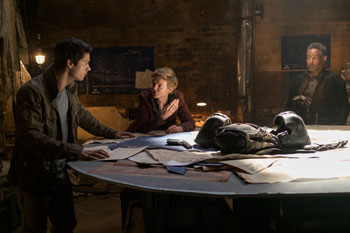 'I was a stranger to you once. Now we're family. And so are they."
'I was a stranger to you once. Now we're family. And so are they."-Brenda to Jorge
Family. It's something that each of the cast members agree on. After nearly five years working together on three films they have unquestionably become a family.
Rosa Salazar believes that being given the opportunity to be together off set as well as on truly contributes to the chemistry. 'It's almost like improv. Improvisers spend every second with each other, because they have to become one brain. When they get on stage there is no like, -Here's what I'm doing…', there are no cues. The cue is in being. It's just a flick of the eye, it's in micro expressions and that's the level to which that Jorge and I have gotten." She smiles: 'We don't have to over verbalise anything. Because we know each other in and out. We're one brain."
As somebody who joined the story in the second film, Giancarlo Esposito says family is something that defines the story: 'That's what this film is about, family. I think it's very unique. When you're working with people that you like, you want to be around them because you're doing things creatively on camera that allow you to know them a little better. So when you hang out with them and play pool, maybe have a beer, you know, play foosball afterhours, you learn more about who they are as real people, and that tends to translate to the screen."
Bringing these relationships to the story, Esposito explains, 'Jorge's a mercenary. He's been out there so long that you find out things about him within this Death Cure movie. Maybe you start to wonder about what allegiance he had before you've seen this movie. So for me in a way, it's watching your children grow up. You have to let them make decisions all on their own, and you have to support those decisions or not. But Jorge starts to change. He starts to have somewhat of a heart and he starts to trust. Trust is a big thing within the family. If you can trust your instincts first and then your offspring second, you may learn something. So I think Jorge's journey is a bit special in this movie cause he is forced to stand back and really watch these young people make decisions that affect their own lives and that's what we do with our children."
Dexter Darden describes the family component as one of the key elements both on screen and off. 'We've been together now for five years so when you hear that term or that word family, it's like you know you've seen people grow up, get married, have kids, go through breakups, go through highs and lows of relationships. At the end of the day no matter what we've been through we've all still been there for each other. And we've had our high moments for sure and we've all had our low moments, and that's part of what growing up is. As long as you can grow up together and you can be there for the highs and lows, that's what makes it special. And so that's what we still have now."
Kaya Scoldelario agrees, pointing out it's the commonalities that cement their bond. 'KiHong and I talk about things that we never would have five years ago. We both have babies that were born ten days apart so we talk about diapers, spit-up, baby things that none of the other guys have any interest in but that's what makes it exactly like a family."
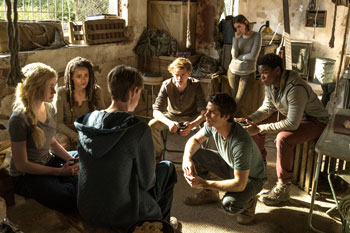 'That city was WCKD's base of operations. If it's still standing it's the last place you want to be. It's the lion's den."
'That city was WCKD's base of operations. If it's still standing it's the last place you want to be. It's the lion's den."-Jorge
Uncertain if this 'last city" had even survived, the 'Gladers" knew that somehow gaining entry would be difficult. To then break in to the WKCD headquarters where Minho was being held, that was impossible. For Thomas, setting difficult goals was not unusual. As Dylan O'Brien says of his character, 'In the first movie the challenge was to solve the maze, to break out of the glade. A big part of the group, led by Gally, wanted no part of that. They looked at the glade as their home and they were safe. In Scorch Trials we were out of the maze, had a building to live in and were taken care of but there was a price to pay. In this film, in Death Cure, Thomas wants to break in to the place that caused all of this to save his friend Minho, which he promised he'd do. Most thought it was a crazy plan."
It is Thomas' fearless approach to any situation that originally attracted director Wes Ball to the trilogy from the start, 'The Thomas character is someone that takes that step forward into the unknown when everyone else takes a step back."
Giancarlo Esposito spoke about his character's conflicted perspective on the audacity of Thomas' plan. 'It's a film about not leaving a man behind. You know we're really trying to find Minho. And that is Thomas' journey. Jorge is skeptical of it, so are some of the other Gladers. You have a big choice to make when you're going after one man who has been captured - what do you do with all of those other young people who you're trying to save? How does that balance out? So it's a conundrum of sorts. I believe, being a father of four, that you never leave a man behind. And so that really poses a big problem, and also quite a bit of excitement in this film." Salazar, whose character Brenda joined the group alongside Jorge agrees, ' Thomas is the catalyst. He's the hero for many, many changes and many, many journeys."
As the target of Thomas' mission, Dr. Ava Paige, played by Patricia Clarkson, sees the WCKD agenda as a very challenging moral dilemma. She describes her character as someone who truly cares for the immunes but she has a drive to succeed that is above all else. 'It's an almost heartbreaking relationship with Thomas. If there's someone who can deeply affect and touch Ava, it's Thomas." Clarkson says. She goes on to explain how failure is not something her character handles easily, 'I don't think she ever thought it would be a part of her life to fail. And she has that very powerful line to Janson when she says -it's not about giving up, it's actually knowing when you've lost.'"
As much as all the characters have maintained the family bond through the first two films, this time with a direct assault on WCKD the strategy has become one of divide and conquer, requiring the group to split into teams to become even stronger.
Dylan O'Brien talks about Thomas' newest mission, 'In the first movies we were all always together, on screen and off. We're all still working together but it's different parts of the same mission so I end up doing a lot of scenes with Will and Thomas. It's more mission oriented so we're all working to get back together."
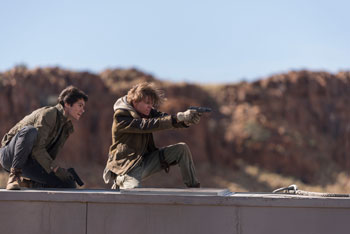 'They can't hide behind their walls forever. Day's gonna come, WCKD's gonna pay for everything they've done."
'They can't hide behind their walls forever. Day's gonna come, WCKD's gonna pay for everything they've done."-Gally
In the first film, the gladers primary goal was to escape. In the second film, they were on the run, staying barely a step ahead of WCKD. Now, as they turn the tables and are on the offensive they find help from an unlikely source: Gally. Thought to have been killed while turning against the others in the last moments before escaping the maze, their old companion and Thomas' adversary is on the forefront of the war against WKCD.
As many fans of the Maze Runner novels know, Gally makes his surprise return in the third book but as author James Dashner describes it, 'Gally was the one who, when back in the maze, never wanted to rock the boat. Now, he's back and he's a soldier leading the war against WCKD. The others, especially Thomas, don't trust him but now Gally wants to defeat WCKD, he wants to bring them down."
For Will Poulter the chance to return to the story as Gally was a great opportunity. 'They had left me to die, they saw Gally kill Chuck but Gally was infected. He has this whole new life that has happened since they were together in the maze and he's a soldier with the Right Arm and he has the opportunity to make amends, if that's possible so it's great to be back."
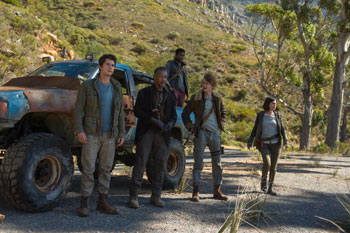 Welcome to the safe haven.
Welcome to the safe haven.-Vince
As the gladers pursue their mission to rescue Minho, they also have a chance to save many of the other immune children captured by WCKD and to be used as test subjects. The tests WKCD is conducting are their attempt to see if the immunes might have what is needed to make a serum to cure the flare.
Playing WCKD's authoritative, mysterious executive director, Patricia Clarkson explains that Dr. Ava Paige's mission is an important one. 'There was a line in the script that we could be responsible for wiping the human race clean from this planet. I think to her, she's saving the world. It's that big in her mind."
Patricia Clarkson also acknowledges that the method may be less than compassionate but that it's simply the nature of her character. 'I think she has a very strong agenda, obviously, and people's feelings, thoughts, emotion are not a large part of her life. They're not particularly important to her. What is important to her is survival. I think as we moved through the three episodes, through the three installments, in this third one you see a slightly more personal side to Ava. You see how she lives in a way. You see she's more affected by human contact or human interaction. I think ultimately you find out in the end she really thought she was doing the right thing." Director Wes Ball confirms that compassionate side saying, 'I've always said that Janson is the real villain of the series."
Aidan Gillen attributes Janson's villainy to simply being devious and a bit power hungry. 'Janson, the character that I play is an employee if you like, of the WCKD corporation. But a very ambitious employee, and I'm not just talking about a drone. He's almost like a secret policeman or something. I mean I didn't give too much away when we were starting off the last film because Janson was initially introduced into the story, or to the kids, if we can call them that, as providing a potential way out or maybe a good guy within this corporate prison environment. But it turns out he wasn't that. We got to see that through the course of the film. At this stage in the story he is even more driven and ruthless and reckless and ambitious you know, with an eye to, I guess, running the show."
Though Ava Paige is behind the ever-repeating message 'WCKD is good" there's plenty of doubt about that in Rosa Salazar's mind. Her character Brenda doesn't believe for a moment that WKCD is the altruistic organization they present themselves to be. 'I don't believe WCKD is good and here's why. They're trampling on the people in order to make money while at the same time telling people we're trying to help. They're harvesting the serum from innocent children. They're trying to capitalize on a very devastating epidemic. They're not doing it for us, and they're not doing it for the good of the people, and they're not doing it to save lives, which is the bulls**t that they hock, they're doing it so that they can make a coin."
At the end of the adventure Giancarlo Esposito credits the filmmakers for doing exactly what needed to be done when creating the scope and scale of this final film in the Maze Runner series. 'I love it." he says. 'It's not only giant but it's also very specific in that it reflects a modern day dystopian western. We've been in some really remote locations out in the Kalahari and we've been out in Saint Helena Bay by the ocean. You really get taken away by the geography of where we're shooting this film in South Africa. The trains that were shipped in and loaded off of trucks and put onto the train tracks and actually ran back and forth, it's unimaginable, the scale of the film. It allows me as an actor to feel like there's really been not only thought put into things, but money invested, real vision to be able to play on a big grand scale and that's what movies are. We want to be taken away when we go to the movies. And I certainly as an actor in the movie have been taken away by just shooting this one. I can't wait to see what it looks like on film."
The artist whose vision first brought the story to the screen five years ago is the same one who will bring it to its conclusion in The Death Cure, director Wes Ball. The fact that there's a single vision, one director for the entire franchise, is very much appreciated by the cast. Thomas Brodie-Sangster smiles as he relates that Ball's enthusiasm has never faltered. 'He'll often be describing the way he sees a scene playing out, being very animated with lots of sound effects and then before you know it he's actually playing all the characters. I[JL1]t's great fun in getting in to the story."
Patricia Clarkson whose role has grown significantly with each installment says, 'I don't think any of these films would work without Wes. It's a singular vision that he has. I don't think it's like a franchise. I think it is just one very long movie. Wes has a very specific style, a very specific vision. His tone is uniquely his and nobody else. It just wouldn't work, these films, without Wes. They're so personal to him, and they're so specific, he's really a dreamboat. I mean he's so lovely to work with because he's so enthusiastic - he's still a kid. I mean he's not, but he is! I think that's why people love the films. Because he's in them."
Giancarlo Esposito appreciates the rhythm the actor/director relationship has found after three films: 'You're always in a place where you're loose and creative. Some actors don't like that, they don't want to come up with anything, but with Wes, with this being the third film that he's done of this series, it's a tribute to him because he could be onto much larger films. I'm sure he's had those offers and he could duck out of this. But instead he really wants to cut his teeth and finish what he started. His vision is so linked to so many different pieces of this. We shoot things, but a lot of this is green screen and visual effects that he has to put in later. So he knows that and remembers what screen directions he wants and where he wants you to look and what moments he needs you not to talk at all, but just to look and he knows how he's going cut it together. So I applaud him for keeping all of those pieces in his head. He guides you through shots which are very important because it takes an imagination, a very big imagination, to cultivate that kind of filmmaking. He's gentle, graceful, calm, he listens, and he's excited. What else could you ask for?"
Esposito also acknowledges that at this stage, Wes Ball knows when to step aside and let the actors figure out what comes naturally. 'I love what Dylan O'Brien does because when we get into a situation where we have to stop for a minute and slow it down and talk about what motivates character, Dylan O'Brien is at the forefront of that. You know we have scenes where you could buy what he's saying, then he realises -Oh, I said something like this three scenes ago. So let me figure out what I can say that's a little bit different. Let me figure out how to have a little bit of a different attitude,' and he's very thorough in his work. I really love working with Dylan because he has the ability to think out of the box. We had a scene with Dylan O'Brien and Barry Pepper, who plays Vince, and myself and Rosa and Dexter, where we're all standing around a table. It's interrupted, the whole scene gets interrupted by Bergs [flying vehicles] coming in and WCKD flying over us and we've got to turn all the lights out and sort of duck out and hide. It was really very interesting because I found that Dylan O'Brien was trying to figure out right where he supposed to be.
Everyone was interjecting other suggestions, and it was lovely. All were valid, all could have worked. Dylan O'Brien was like you know, -Maybe we do a piece of this, a piece of that', and then he went back and he went -No, I think this is it, thanks guys, I think I got, it let's try this'. He was very appreciative of everyone's suggestions because he realized all we want to do is be helpful and make a great film. In the end he also realised that he had to find the balance of the character, which he's lived with for so long, on his own. And when he finally said -Hey thanks guys, I think I got it', he was very confident, he appreciated it, and he knocked it out of the park. That's someone who is thinking about what he does. Equally so, Rosa Salazar, same way. Very thorough. And we have actors here who really do look at the script. Who really do take in what they've said from day one, like Dylan O'Brien. How do you keep that in your head? It's the third film, but he knows the trajectory of his character and he wants to honor that."
Dylan O'Brien can't help but get a little sentimental thinking back from the very first film working with Ball, 'He's the most even-keeled human being I've ever seen in my life," smiles Dylan O'Brien. 'He won't go up or down. He's always just this very supportive, very positive, very stoically kind of confident guy. Nothing arrogant about him, though, like nothing offputting, he's the most likable, infectious energy that you can have around, as a director. He's got this balance of being insanely intelligent, and a genius for visual effects, for storytelling, for filmmaking, and also like have this amazing human and little-kid quality, where he's very normal and a very humble dude. Which is insane, I mean, I don't know, he did something the other day, he does this amazing thing where like no matter what mood you're in, if you get yourself in any place he can always pick you back up, man, like that dude always picks me up."
As the director of the entire series, Wes Ball is appreciative of the cast member's dedication to each other, their devotion to the series and the camaraderie they've maintained. Reflecting back to the first film, Wes Ball says, 'When I first came on, I wanted to get all of them into a group together. I wanted them to spend like a whole week out in the glade, out on their own, just learning how to survive. And we brought out this awesome guy that, you know, um, kind of trained them with, in survival, and they learned how to like get their fingernails dirty, all these city boys, you know, make them feel like they belonged in this place."
He continues, 'At the same time that connected these guys in a way that has just been really, really special, because like they'll pick themselves up when they're tired or something's not working right. It's just a really awesome little family of these guys that have just become, I think, friends for life. It's been a lot of fun kind of helping them, making it real for them, you know what I mean? So I'm happy about that."
Maze Runner: The Death Cure
Release Date: January 18th, 2018
Have You Seen This?
MORE



